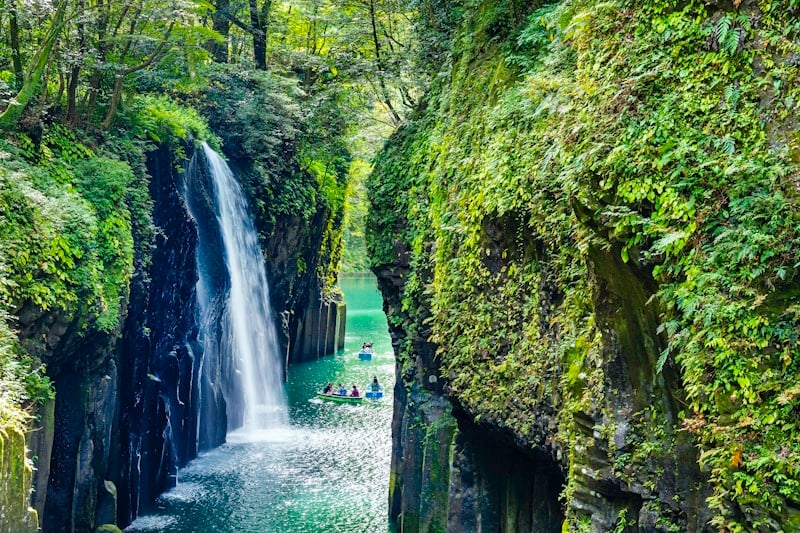[ad_1]
A fun tourist activity turned sour for a number of people in Japan’s Ishikawa Prefecture. Here’s how the usually fun practice of nagashi-sōmen gave 93 people – and possibly hundreds more – a health scare.
Downfall: Noodles and reputation

For over 30 years, Ōtaki (大滝) has been the perfect summer spot. Literally meaning “great waterfall,” Ōtaki’s crystal clear water splashed on moss-covered rocks before gently flowing into a stream where natural trout swam about.
Beside the river, a restaurant overlooks Ōtaki, its cone-shaped roof donned in as much moss as the river rocks. The building’s beams are the shade of red reminiscent of torii gates.
The name of the restaurant is Ōtaki Sōmen (大滝そうめん). It is open only during the summer months. This year, the restaurant closed its doors early due to a cluster of food poisoning cases.
Located on the riverbank of Kikubo River of Ishikawa Prefecture, Ōtaki Sōmen’s specialty is in the name. Sōmen, or more specifically, nagashi-sōmen (流しそうめん), is the restaurant’s main attraction for summer vacationers. But this summer, these flowing noodles became the restaurant’s first badge of shame in the plus thirty years it’s been in business.
Public health officials have confirmed 93 people fell ill from food poisoning after eating at Ōtaki Sōmen, according to reports by Japanese media this week on September 1st. An additional 500 citizens have reported concerning symptoms.
The cause: Water contaminated…by boars?
Noodles are not the kind of food people usually expect to get food poisoning from – unlike undercooked meat, for example. But nagashi-sōmen is an exception, as noodles do not directly transfer from a sterile kitchen to customers’ tables.
Advertisements
Many traditional establishments like Ōtaki Sōmen cook their noodles in a kitchen as expected. But then, instead of plating the noodles, they stream them––in river water. The restaurant delivers noodles to each customer in a stream of fast-flowing water that flows through a cut-open bamboo shoot.
The rest is up to the customer. Customers scoop up the noodles from the stream and into their cups of sauce with their chopsticks.
That would have been the end of it if the water at Ōtaki Sōmen was clean. But when the local health center took samples of Ōtaki’s river water, it tested positive for campylobacter bacteria. Campylobacter is Japan’s most common bacteria that causes diarrheal illness and food poisoning.
Recent reports raise the possibility that boars that witnesses sighted near Ōtaki Sōmen’s water source may have left droppings in the water, leading to contamination.
Avoidable accident
Visitors looked forward to this year’s nagashisōmen at Ōtaki. Event organizers had postponed it for the past three years due to public health restrictions.
Despite many looking forward to nagashisōmen’s comeback, the restaurant’s organizers failed to test the river water’s quality before its opening date on July 23rd. No law required the restaurant to run tests before the opening date. However, that might have prevented the cluster of food poisoning cases.
The organizers claim that they failed to test the water due to heavy rainfall that had happened in earlier weeks. Ōtaki Sōmen tested the water only after the first reports of food poisoning symptoms came out.
The prefectural government shut down the restaurant for three days between August 17th and 19th before the establishment closed its doors for the summer.
Severe symptoms
“I had to keep going to the bathroom every 30 minutes. My fever was high, and I had diarrhea. My fever got as high as 39.8 degrees,” said one woman who ate at Ōtaki Sōmen with her famliy.
Patients range between ages two and fifty. Authorities expect all to recover.
Ōtaki Sōmen has issued an apology online to victims. It will return next year with more thorough testing…that is, if its reputation survives.
Nagashisōmen’s origins

The practice of nagashi-sōmen began in 1955 in Takachiho Town of Miyazaki Prefecture. Legend has it that a farmer working the fields in the hot summer got the idea to eat cold noodles outdoors and started the tradition.
The area is also known for sōmen-nagashi. This is similar to nagashi-sōmen but different in that instead of using natural water flow through bamboo shoots, it uses filtered water from a machine that flows around a seated table.
Noodles flowing over 3500 meters
In November 2022, Takamori Town in Nagano Prefecture won the Guinness World Record for the longest nagashisōmen at 3,515.42 meters. The previous record was shorter by 200 meters.
The challenge was an effort to make use of abandoned bamboo forests. Local junior high school students spent a year building the nagashisōmen bamboo structure.
From the head of the bamboo, the noodles took an hour until they reached the stream’s end.
What to read next
The Soba Big Three: Enjoy These Regional Variations On Your Next Japan Trip
Sources
[1] “流しそうめん”で93人食中毒500人調査中 湧き水から「カンピロバクター」検出豪雨で水質検査行わず. Yahoo!ニュースJAPAN
[2] 石川・津幡 名物の流しそうめん復活 4年ぶりに涼を求めて. NHK
[3] 流しそうめん店で93人食中毒、さらに500人から相談…水質検査せず湧き水使用. 読売新聞
[4] 【追跡】流しそうめんで93人食中毒の謎 原因の「カンピロバクター」どこから?湧き水近くにイノシシが. Yahoo!ニュースJAPAN
[5] 流しそうめんの起源. そうめんの山道
[ad_2]
Source link



